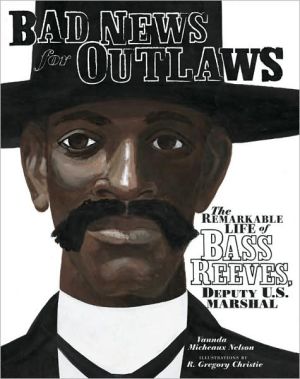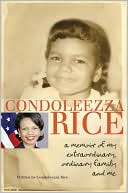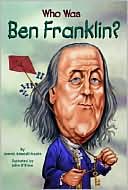Bad News for Outlaws: The Remarkable Life of Bass Reeves, Deputy U.S. Marshall
Sitting tall in the saddle, with a wide-brimmed black hat and twin Colt pistols on his belt, Bass Reeves seemed bigger than life. Outlaws feared him. Law-abiding citizens respected him. As a peace officer, he was cunning and fearless. When a lawbreaker heard Bass Reeves had his warrant, he knew it was the end of the trail, because Bass always got his man, dead or alive. He achieved all this in spite of whites who didn't like the notion of a black lawman. Born into slavery in 1838, Bass had a...
Search in google:
Sitting tall in the saddle, with a wide-brimmed black hat and twin Colt pistols on his belt, Bass Reeves seemed bigger than life. Outlaws feared him. Law-abiding citizens respected him. As a peace officer, he was cunning and fearless. When a lawbreaker heard Bass Reeves had his warrant, he knew it was the end of the trail, because Bass always got his man, dead or alive. He achieved all this in spite of whites who didn't like the notion of a black lawman. Born into slavery in 1838, Bass had a hard and violent life, but he also had a strong sense of right and wrong that others admired. When Judge Isaac Parker tried to bring law and order to the lawless Indian Territories, he chose Bass to be a deputy U.S. Marshall. Bass would quickly prove a smart choice. For three decades, Bass was the most feared and respected lawman in the territories. He made more than 3,000 arrests, and though he was a crack shot and a quick draw, he only killed fourteen men in the line of duty. The story of Bass Reeves is the story of a remarkable African American and a remarkable hero of the Old West.The Washington Post - Abby McGanney NolanBad News for Outlaws"is a great introduction to a little-known lawman who did more than his share of Wild West wrangling…Nelson has fun with Old West wording as she tells of Reeves's clever ploys. The same exuberance and skill are evident in the striking paintings by R. Gregory Christie. Subtly stylized, featuring gorgeous colors, they capture big skies and rugged landscapes as well as the way Reeves honorably navigated a rough-and-tumble world.
\ Abby McGanney NolanBad News for Outlaws"is a great introduction to a little-known lawman who did more than his share of Wild West wrangling…Nelson has fun with Old West wording as she tells of Reeves's clever ploys. The same exuberance and skill are evident in the striking paintings by R. Gregory Christie. Subtly stylized, featuring gorgeous colors, they capture big skies and rugged landscapes as well as the way Reeves honorably navigated a rough-and-tumble world.\ —The Washington Post\ \ \ \ \ Publishers WeeklyWith lively language and anecdotes, Nelson (Juneteenth) chronicles the life of African-American lawman Bass Reeves in a biography that elevates him to folk hero. The story opens with an action-packed sequence leading to Reeves killing criminal Jim Webb. The second spread has readers staring down the barrel of Reeves's rifle, in an attention-grabbing, somewhat unsettling closeup. As Webb lay dying, he “gave Bass his revolver out of respect. Bass buried Webb's body and turned in the outlaw's boots and gun belt as proof he'd gotten his man.” Christie's (Yesterday I Had the Blues) dynamic full-page oil paintings portray a somber, statuesque Reeves, his big eyes shining from under the brim of his deputy's hat. The folksy language is heavy with simile (“Bass took to guns like a bear to honey”) and jargon (vittles, slack-jawed cowpoke), inviting a drawly reading. It's an arresting portrait of a man who rose from escaped slave in Indian Territory (now Oklahoma) to become a federal marshal who made thousands of arrests, including his own son, but killed only 14 men. A glossary, bibliography, time line and other source material are included. Ages 8–12. (Oct.)\ \ \ Children's LiteratureBass Reeves was born into slavery in 1838 and after slavery ended, became one of the most respected lawmen in the American West. In his career as a Deputy US Marshal, a career that spanned more than thirty years, he made more than 3000 arrests, including the notorious Belle Starr, who turned herself in upon hearing that Reeves had her warrant. By his own reckoning, he only had to kill fourteen men, even though his orders were to bring them in alive or dead. This book details the life of this remarkable man. The illustrations are captivating and readers will appreciate the added features in the book including a timeline, a glossary of western words like shooting irons and squatters, a list of readings for further information, more about Judge Parker (who first hired Reeves), more about The Indian Territory (where Reeves worked as a US Marshal) and a selected bibliography. There is also a note explaining how the author first heard about Marshal Reeves. Reviewer: Ellen Welty\ \ \ \ \ School Library JournalGr 3–8—Reeves is an unsung hero of the American West whose honesty and sense of duty are an inspiration to all. In a frontier brimming with treachery and lawlessness, this African-American peace officer stood out as a fearless figure of unparalleled integrity, arresting more than 3,000 outlaws during his 32 years of service as a deputy U.S. marshal, all without suffering an injury. He was a former slave who became a successful farmer and family man before accepting the appointment to serve as a lawman in the Indian Territory in 1875. While Gary Paulsen's The Legend of Bass Reeves (Random, 2006) mixes fact and fiction to great effect, Nelson chooses to keep her telling as close to documented research as possible. Selected anecdotes ranging from a humorous encounter with a skunk to an intense gunfight with an outlaw provide a sense of the man's courage and character. The text is chock-full of colorful turns of phrase that will engage readers who don't "cotton to" nonfiction (a glossary of "Western Words" is included). Christie's memorable paintings convey Reeves's determination and caring, while rugged brushstrokes form the frontier terrain. Youngsters will find much to admire here.—Lisa Glasscock, Columbine Public Library, Littleton, CO\ \ \ \ \ Kirkus ReviewsHe rode tall in the saddle and excelled at riding, shooting, tracking and every other skill required of a man representing the law in the vast and often lawless American frontier known as Indian Territory in the late 1800s. Born into slavery in Texas, he fled from his owner during the Civil War and lived with Indians, honing his skills until he was chosen for what turned out to be a very long and very successful career as a deputy U.S. Marshal. Nelson's well-researched biography reads much like a tall tale or frontier legend-as well it should: "Outlaws learned that when Marshal Reeves had your warrant, you were as good as got . . . ." Christie's bold full-page paintings echo the heroic spirit. The text is frequently laid out in the style of old-time wanted posters on yellowing paper. Gary Paulsen's The Legend of Bass Reeves (2006) previously presented his life as a novel. Here, children can saddle up with a genuine Western hero in a narrative that hits the bull's-eye. (glossary, timeline, bibliography, notes) (Picture book/biography. 7-10)\ \








